ESP Citroen C4 PICASSO DAG 2008.5 1.G Owner's Guide
[x] Cancel search | Manufacturer: CITROEN, Model Year: 2008.5, Model line: C4 PICASSO DAG, Model: Citroen C4 PICASSO DAG 2008.5 1.GPages: 330, PDF Size: 13.13 MB
Page 157 of 330
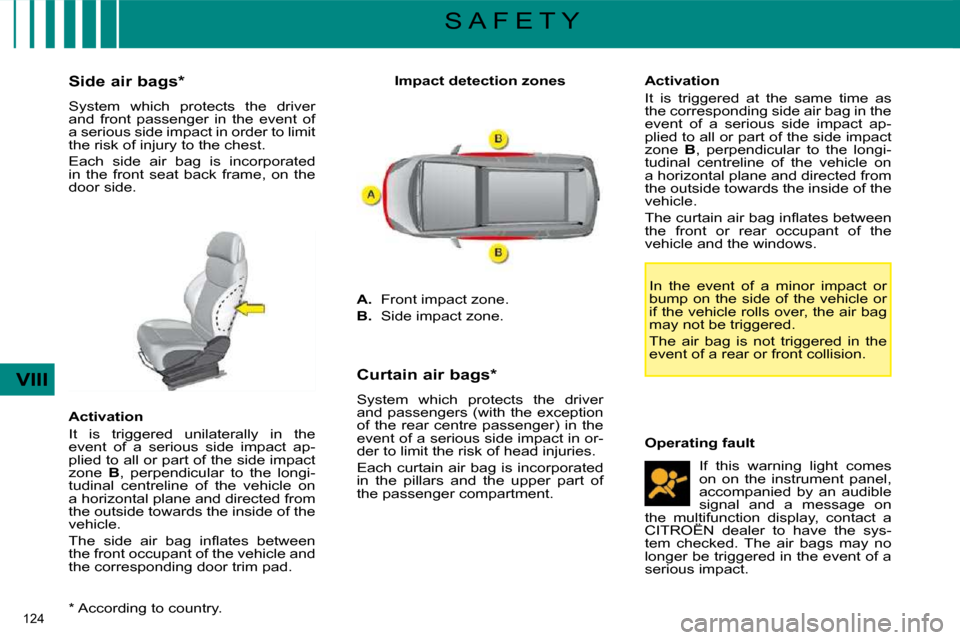
124
VIII
S A F E T Y
* According to country.
Side air bags *
System which protects the driver
and front passenger in the event of
a serious side impact in order to limit
the risk of injury to the chest.
Each side air bag is incorporated
in the front seat back frame, on the
door side.
Activation
It is triggered unilaterally in the
event of a serious side impact ap-
plied to all or part of the side impact
zone
B , perpendicular to the longi-
tudinal centreline of the vehicle on
a horizontal plane and directed from
the outside towards the inside of the
vehicle.
� �T�h�e� �s�i�d�e� �a�i�r� �b�a�g� �i�n�fl� �a�t�e�s� �b�e�t�w�e�e�n�
the front occupant of the vehicle and
the corresponding door trim pad. Impact detection zones
A. Front impact zone.
B. Side impact zone.
Curtain air bags*
System which protects the driver
�a�n�d� �p�a�s�s�e�n�g�e�r�s� �(�w�i�t�h� �t�h�e� �e�x�c�e�p�t�i�o�n�
of the rear centre passenger) in the
event of a serious side impact in or-
der to limit the risk of head injuries.
Each curtain air bag is incorporated
in the pillars and the upper part of
the passenger compartment. Activation
It is triggered at the same time as
the corresponding side air bag in the
event of a serious side impact ap-
plied to all or part of the side impact
zone
B , perpendicular to the longi-
tudinal centreline of the vehicle on
a horizontal plane and directed from
the outside towards the inside of the
vehicle.
� �T�h�e� �c�u�r�t�a�i�n� �a�i�r� �b�a�g� �i�n�fl� �a�t�e�s� �b�e�t�w�e�e�n�
the front or rear occupant of the
vehicle and the windows.
In the event of a minor impact or
bump on the side of the vehicle or
if the vehicle rolls over, the air bag
may not be triggered.
The air bag is not triggered in the
event of a rear or front collision.
Operating fault
If this warning light comes on on the instrument panel, accompanied by an audible signal and a message on the multifunction display, contact a CITROËN dealer to have the sys-the multifunction display, contact a the multifunction
tem checked. The air bags may no longer be triggered in the event of a serious impact.
Page 163 of 330
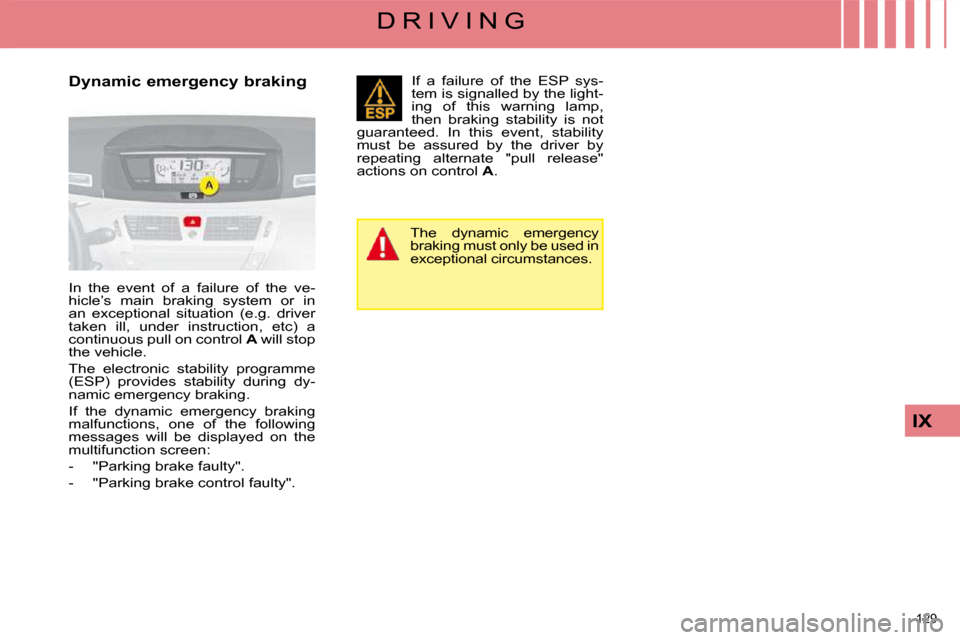
129
IX
D R I V I N G
Dynamic emergency braking
In the event of a failure of the ve-
hicle’s main braking system or in
an exceptional situation (e.g. driver
taken ill, under instruction, etc) a
continuous pull on control A will stop
the vehicle.
The electronic stability programme
(ESP) provides stability during dy-
namic emergency braking.
If the dynamic emergency braking
malfunctions, one of the following
messages will be displayed on the
multifunction screen:
- "Parking brake faulty".
- "Parking brake control faulty". If a failure of the ESP sys-
tem is signalled by the light-
ing of this warning lamp,
then braking stability is not
guaranteed. In this event, stability
must be assured by the driver by
repeating alternate "pull release"
actions on control A .
The dynamic emergency
braking must only be used in
exceptional circumstances.
Page 170 of 330

135
IX
D R I V I N G
Displays on the instrument panel
- The selector position is displayed in the instrument panel, on the
left on multifunction screens A
and C and on the right on the
NaviDrive multifunction screen.
- A background-lit position grille associated with the selector
allows you to view the position
selected.
When the ignition is on,
lighting of the service
warning lamp, accompa-
nied by a sound signal and the
message "Gearbox faulty" indi-
cates a malfunction.
Consult a CITROËN dealer.
For safety:
� Position N can only be disen-
gaged if you are pressing the
brake pedal.
� If the gearbox is in position N
but the selector position is differ-
ent, reposition the selector on N
in order to be able to start. Moving off
� To start the engine, the selector
has to be in position N .
� � � �P�r�e�s�s� �fi� �r�m�l�y� �o�n� �t�h�e� �b�r�a�k�e� �p�e�d�a�l�.�
� Action the starter.
� When the engine is running,
place the selector on R , A or M
as desired.
� Check, in the instrument panel,
the position engaged.
� Release the brake pedal and
accelerate.
If the selector is not in position N ,
and/or if the brake pedal is not
pressed, the corresponding warning
lamp(s) are displayed and a mes-
sage informs you that at least one of
these two conditions is not met.
In this case, the engine will not start,
recommence the above procedure. Reverse gear
Engaging reverse gear
To engage reverse gear, move the
selector to R .
Only attempt to change to reverse
gear when the vehicle is stationary.
If the vehicle is moving rapidly, if an in-
advertent attempt to engage reverse
gear is made, the warning lamp N will
�fl� �a�s�h� �a�n�d� �y�o�u�r� �v�e�h�i�c�l�e� �w�i�l�l� �g�o� �a�u�t�o�-
matically into neutral. To re-engage a
gear, you have only to reposition the
selector on A , M or R .
Neutral Changing to neutral
To change to neutral, move the
selector to N . If the vehicle is
moving, do not select this position
even momentarily.
Page 180 of 330
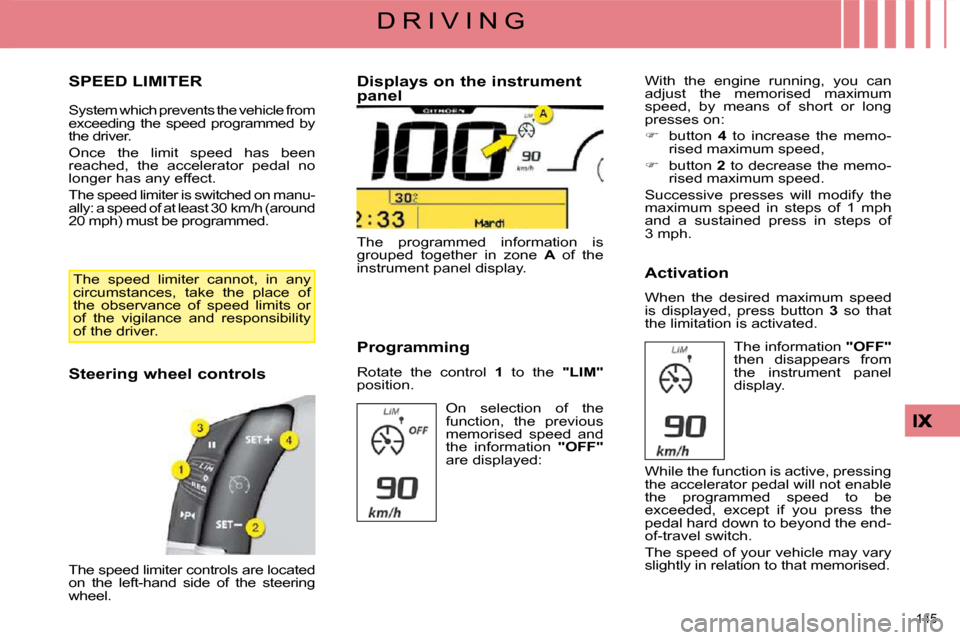
145
D R I V I N G
SPEED LIMITER
System which prevents the vehicle from
exceeding the speed programmed by
the driver.
Once the limit speed has been
reached, the accelerator pedal no
longer has any effect.
The speed limiter is switched on manu-
ally: a speed of at least 30 km/h (around
20 mph) must be programmed.
The speed limiter controls are located
on the left-hand side of the steering
wheel. The programmed information is
grouped together in zone
A of the
instrument panel display.
Steering wheel controls Displays on the instrument
panel
Programming
Rotate the control
1 to the "LIM"
position. With the engine running, you can
adjust the memorised maximum
speed, by means of short or long
presses on:
� button 4 to increase the memo-
rised maximum speed,
� button 2 to decrease the memo-
rised maximum speed.
Successive presses will modify the
maximum speed in steps of 1 mph
and a sustained press in steps of
3 mph.
Activation
When the desired maximum speed
is displayed, press button 3 so that
the limitation is activated.
On selection of the
function, the previous
memorised speed and
the information "OFF"
are displayed: The information
"OFF"
then disappears from
the instrument panel
display.
While the function is active, pressing
the accelerator pedal will not enable
the programmed speed to be
exceeded, except if you press the
pedal hard down to beyond the end-
of-travel switch.
The speed of your vehicle may vary
slightly in relation to that memorised.
The speed limiter cannot, in any
circumstances, take the place of
the observance of speed limits or
of the vigilance and responsibility
of the driver.
Page 182 of 330
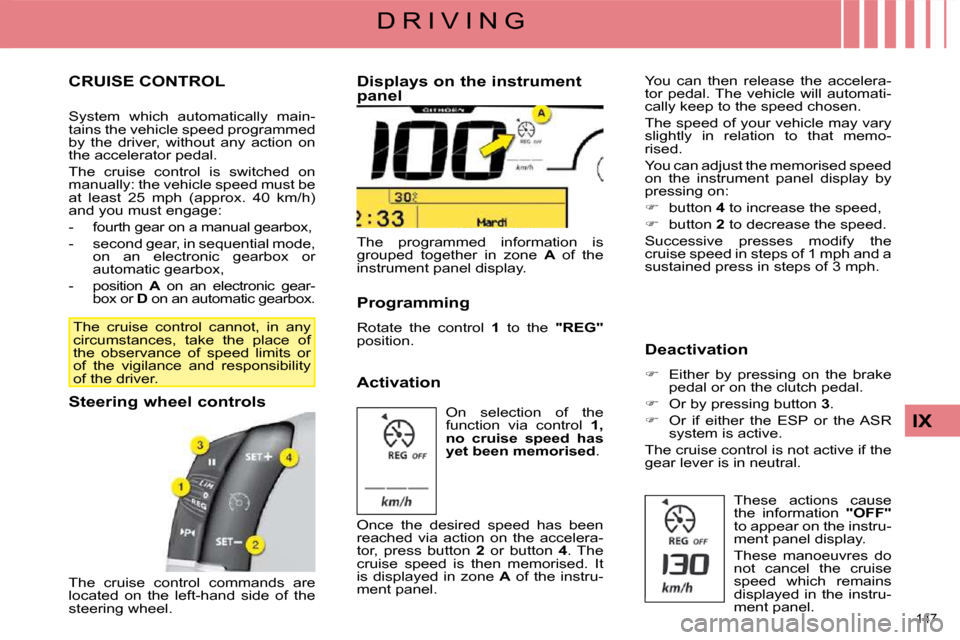
147
IX
D R I V I N G
CRUISE CONTROL
System which automatically main-
tains the vehicle speed programmed
by the driver, without any action on
the accelerator pedal.
The cruise control is switched on
manually: the vehicle speed must be
at least 25 mph (approx. 40 km/h)
and you must engage:
- fourth gear on a manual gearbox,
- second gear, in sequential mode, on an electronic gearbox or
automatic gearbox,
- position A on an electronic gear-
box or D on an automatic gearbox.
Steering wheel controls
The cruise control commands are
located on the left-hand side of the
steering wheel. The programmed information is
grouped together in zone
A of the
instrument panel display.
Displays on the instrument
panel
Activation You can then release the accelera-
tor pedal. The vehicle will automati-
cally keep to the speed chosen.
The speed of your vehicle may vary
slightly in relation to that memo-
rised.
You can adjust the memorised speed
on the instrument panel display by
pressing on:
� button 4 to increase the speed,
� button 2 to decrease the speed.
Successive presses modify the
cruise speed in steps of 1 mph and a
sustained press in steps of 3 mph.
Deactivation
� Either by pressing on the brake
pedal or on the clutch pedal.
� Or by pressing button 3 .
� Or if either the ESP or the ASR
system is active.
The cruise control is not active if the
gear lever is in neutral.
On selection of the
function via control
1,
no cruise speed has
yet been memorised .
Programming
Rotate the control
1 to the "REG"
position.
Once the desired speed has been
reached via action on the accelera-
tor, press button 2 or button 4 . The
cruise speed is then memorised. It
is displayed in zone A of the instru-
ment panel. These actions cause
the information
"OFF"
to appear on the instru-
ment panel display.
These manoeuvres do
not cancel the cruise
speed which remains
displayed in the instru-
ment panel.
The cruise control cannot, in any
circumstances, take the place of
the observance of speed limits or
of the vigilance and responsibility
of the driver.
Page 186 of 330

151
IX
D R I V I N G
LANE DEPARTURE WARNING SYSTEM
System which detects the involun-
�t�a�r�y� �c�r�o�s�s�i�n�g� �o�f� �l�o�n�g�i�t�u�d�i�n�a�l� �t�r�a�f�fi� �c�
lane markings on the ground (con-
tinuous or discontinuous line).
� �S�e�n�s�o�r�s�,� �fi� �t�t�e�d� �b�e�l�o�w� �t�h�e� �f�r�o�n�t�
bumper, trigger a warning if the vehi-
cle drifts (speed higher than 50 mph
(80 km/h)).
This system operates to its full
potential above all when used on
motorways and main roads. Activation
� Press button A , the indicator light
comes on.
Deactivation
� Press button A again, the indica-
tor light switches off.
The status of the system remains
in the memory when the ignition is
switched off.
Detection
You are warned by the vibration of
the driver's seat cushion:
- on the right-hand side, if the marking on the ground has been
crossed on the right,
- on the left-hand side, if the mark- ing on the ground has been
crossed on the left.
No warning is transmitted while the
direction indicator is active and for
approximately 20 seconds after the
direction indicator is switched off.
A warning may be transmitted
if a direction marking (arrow) or
�n�o�n�-�s�t�a�n�d�a�r�d� �m�a�r�k�i�n�g� �(�g�r�a�f�fi� �t�i�)� �i�s�
crossed. Operating fault
In the event of a malfunction, the
service warning light comes on, ac-
companied by an audible signal and a
message on the multifunction display.
Consult a CITROËN dealer.
The lane departure warning system
cannot, in any circumstances,
replace the need for vigilance and
responsibility on the part of the driver. The detection may be disrupted:
- if the sensors are dirty (mud,
snow, ...),
- if the markings on the ground are worn,
- if there is little contrast between the markings on the ground and
the road surface.
Page 187 of 330
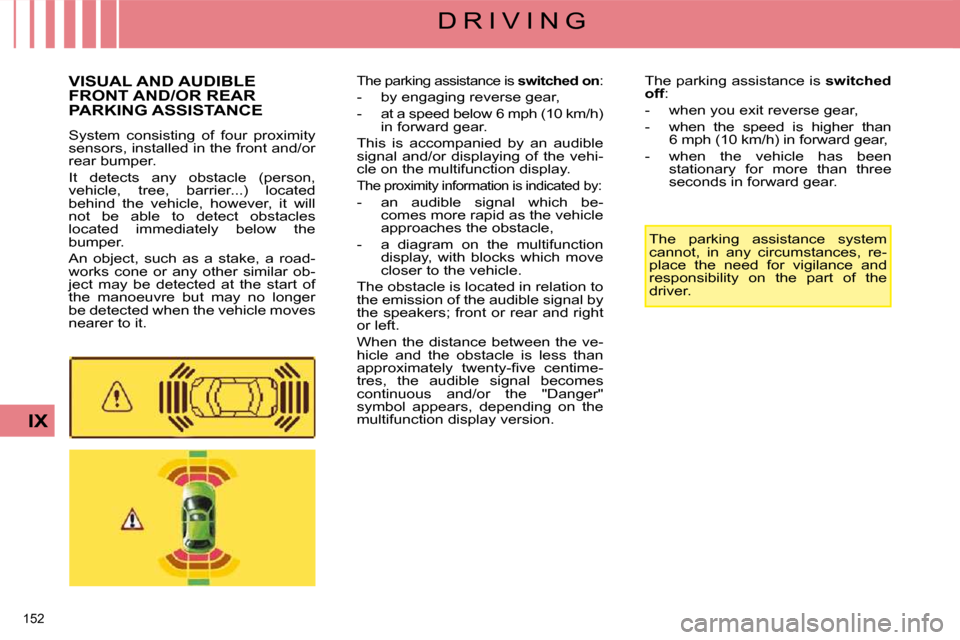
152
IX
D R I V I N G
VISUAL AND AUDIBLE FRONT AND/OR REAR PARKING ASSISTANCE
System consisting of four proximity
sensors, installed in the front and/or
rear bumper.
It detects any obstacle (person,
vehicle, tree, barrier...) located
behind the vehicle, however, it will
not be able to detect obstacles
located immediately below the
bumper.
An object, such as a stake, a road-
works cone or any other similar ob-
ject may be detected at the start of
the manoeuvre but may no longer
be detected when the vehicle moves
nearer to it. The parking assistance is
switched
off :
- when you exit reverse gear,
- when the speed is higher than 6 mph (10 km/h) in forward gear,
- when the vehicle has been stationary for more than three
seconds in forward gear.
The parking assistance system
cannot, in any circumstances, re-
place the need for vigilance and
responsibility on the part of the
driver.
The parking assistance is switched on :
- by engaging reverse gear,
- at a speed below 6 mph (10 km/h)
in forward gear.
This is accompanied by an audible
signal and/or displaying of the vehi-
cle on the multifunction display.
The proximity information is indicated by:
- an audible signal which be- comes more rapid as the vehicle
approaches the obstacle,
- a diagram on the multifunction display, with blocks which move
closer to the vehicle.
The obstacle is located in relation to
the emission of the audible signal by
the speakers; front or rear and right
or left.
When the distance between the ve-
hicle and the obstacle is less than
�a�p�p�r�o�x�i�m�a�t�e�l�y� �t�w�e�n�t�y�-�fi� �v�e� �c�e�n�t�i�m�e�-
tres, the audible signal becomes
continuous and/or the "Danger"
symbol appears, depending on the
multifunction display version.
Page 196 of 330
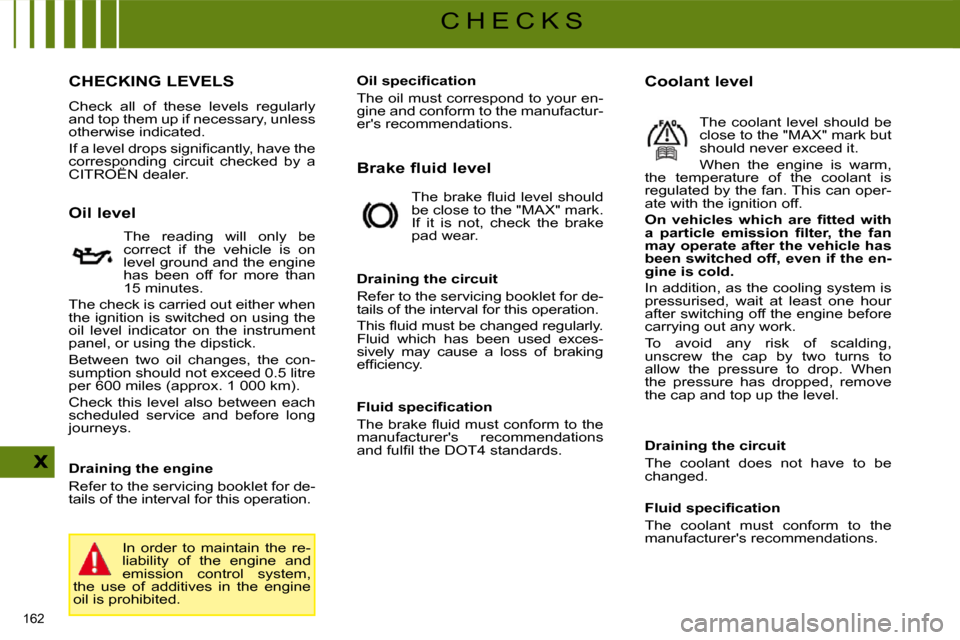
162
C H E C K S
CHECKING LEVELS
Check all of these levels regularly
and top them up if necessary, unless
otherwise indicated.
� �I�f� �a� �l�e�v�e�l� �d�r�o�p�s� �s�i�g�n�i�fi� �c�a�n�t�l�y�,� �h�a�v�e� �t�h�e�
corresponding circuit checked by a
CITROËN dealer.
Oil level
Draining the engine
Refer to the servicing booklet for de-
tails of the interval for this operation. � � �O�i�l� �s�p�e�c�i�fi� �c�a�t�i�o�n�
The oil must correspond to your en-
gine and conform to the manufactur-
er's recommendations.
Brake fluid level
Draining the circuit
Refer to the servicing booklet for de-
tails of the interval for this operation.
�T�h�i�s� �fl� �u�i�d� �m�u�s�t� �b�e� �c�h�a�n�g�e�d� �r�e�g�u�l�a�r�l�y�.�
Fluid which has been used exces-
sively may cause a loss of braking
�e�f�fi� �c�i�e�n�c�y�.� �
� � �F�l�u�i�d� �s�p�e�c�i�fi� �c�a�t�i�o�n�
� �T�h�e� �b�r�a�k�e� �fl� �u�i�d� �m�u�s�t� �c�o�n�f�o�r�m� �t�o� �t�h�e�
manufacturer's recommendations
�a�n�d� �f�u�l�fi� �l� �t�h�e� �D�O�T�4� �s�t�a�n�d�a�r�d�s�.� � �
Coolant level
Draining the circuit
The coolant does not have to be
changed.
� � �F�l�u�i�d� �s�p�e�c�i�fi� �c�a�t�i�o�n�
The coolant must conform to the
manufacturer's recommendations.
The reading will only be
correct if the vehicle is on
level ground and the engine
has been off for more than
15 minutes.
The check is carried out either when
the ignition is switched on using the
oil level indicator on the instrument
panel, or using the dipstick.
Between two oil changes, the con-
sumption should not exceed 0.5 litre
per 600 miles (approx. 1 000 km).
Check this level also between each
scheduled service and before long
journeys. � �T�h�e� �b�r�a�k�e� �fl� �u�i�d� �l�e�v�e�l� �s�h�o�u�l�d�
be close to the "MAX" mark.
If it is not, check the brake
pad wear.
The coolant level should be
close to the "MAX" mark but
should never exceed it.
When the engine is warm,
the temperature of the coolant is
regulated by the fan. This can oper-
ate with the ignition off.
�O�n� �v�e�h�i�c�l�e�s� �w�h�i�c�h� �a�r�e� �fi� �t�t�e�d� �w�i�t�h�
�a� �p�a�r�t�i�c�l�e� �e�m�i�s�s�i�o�n� �fi� �l�t�e�r�,� �t�h�e� �f�a�n�
may operate after the vehicle has
�b�e�e�n� �s�w�i�t�c�h�e�d� �o�f�f�,� �e�v�e�n� �i�f� �t�h�e� �e�n�-
gine is cold.
In addition, as the cooling system is
pressurised, wait at least one hour
after switching off the engine before
carrying out any work.
To avoid any risk of scalding,
unscrew the cap by two turns to
allow the pressure to drop. When
the pressure has dropped, remove
the cap and top up the level.
In order to maintain the re-
liability of the engine and
emission control system,
the use of additives in the engine
oil is prohibited.
Page 251 of 330
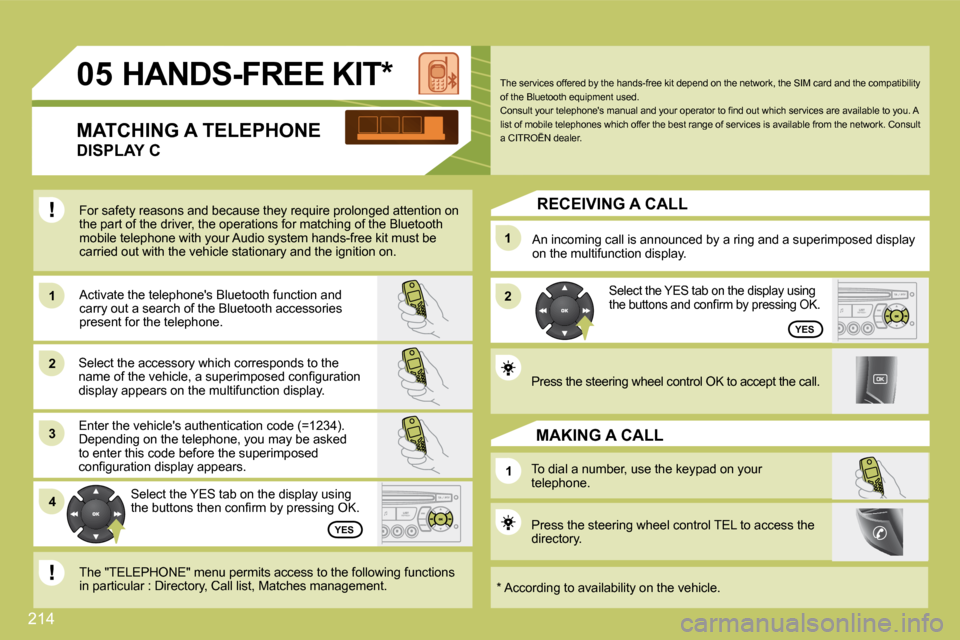
�2�1�4
11
22
33
11
22
44
11
05 HANDS-FREE KIT *
� �F�o�r� �s�a�f�e�t�y� �r�e�a�s�o�n�s� �a�n�d� �b�e�c�a�u�s�e� �t�h�e�y� �r�e�q�u�i�r�e� �p�r�o�l�o�n�g�e�d� �a�t�t�e�n�t�i�o�n� �o�n� �t�h�e� �p�a�r�t� �o�f� �t�h�e� �d�r�i�v�e�r�,� �t�h�e� �o�p�e�r�a�t�i�o�n�s� �f�o�r� �m�a�t�c�h�i�n�g� �o�f� �t�h�e� �B�l�u�e�t�o�o�t�h� �m�o�b�i�l�e� �t�e�l�e�p�h�o�n�e� �w�i�t�h� �y�o�u�r� �A�u�d�i�o� �s�y�s�t�e�m� �h�a�n�d�s�-�f�r�e�e� �k�i�t� �m�u�s�t� �b�e� �c�a�r�r�i�e�d� �o�u�t� �w�i�t�h� �t�h�e� �v�e�h�i�c�l�e� �s�t�a�t�i�o�n�a�r�y� �a�n�d� �t�h�e� �i�g�n�i�t�i�o�n� �o�n�.�
Select the accessory which corresponds to the �n�a�m�e� �o�f� �t�h�e� �v�e�h�i�c�l�e�,� �a� �s�u�p�e�r�i�m�p�o�s�e�d� �c�o�n�fi� �g�u�r�a�t�i�o�n� display appears on the multifunction display.
� �A�c�t�i�v�a�t�e� �t�h�e� �t�e�l�e�p�h�o�n�e�'�s� �B�l�u�e�t�o�o�t�h� �f�u�n�c�t�i�o�n� �a�n�d� �c�a�r�r�y� �o�u�t� �a� �s�e�a�r�c�h� �o�f� �t�h�e� �B�l�u�e�t�o�o�t�h� �a�c�c�e�s�s�o�r�i�e�s� present for the telephone.
� �S�e�l�e�c�t� �t�h�e� �Y�E�S� �t�a�b� �o�n� �t�h�e� �d�i�s�p�l�a�y� �u�s�i�n�g� �t�h�e� �b�u�t�t�o�n�s� �t�h�e�n� �c�o�n�fi� �r�m� �b�y� �p�r�e�s�s�i�n�g� �O�K�.�
� �E�n�t�e�r� �t�h�e� �v�e�h�i�c�l�e�'�s� �a�u�t�h�e�n�t�i�c�a�t�i�o�n� �c�o�d�e� �(�=�1�2�3�4�)�.� � �D�e�p�e�n�d�i�n�g� �o�n� �t�h�e� �t�e�l�e�p�h�o�n�e�,� �y�o�u� �m�a�y� �b�e� �a�s�k�e�d� to enter this code before the superimposed �c�o�n�fi� �g�u�r�a�t�i�o�n� �d�i�s�p�l�a�y� �a�p�p�e�a�r�s�.�
YES
YES
� �T�h�e� �s�e�r�v�i�c�e�s� �o�f�f�e�r�e�d� �b�y� �t�h�e� �h�a�n�d�s�-�f�r�e�e� �k�i�t� �d�e�p�e�n�d� �o�n� �t�h�e� �n�e�t�w�o�r�k�,� �t�h�e� �S�I�M� �c�a�r�d� �a�n�d� �t�h�e� �c�o�m�p�a�t�i�b�i�l�i�t�y� �o�f� �t�h�e� �B�l�u�e�t�o�o�t�h� �e�q�u�i�p�m�e�n�t� �u�s�e�d�.� � �C�o�n�s�u�l�t� �y�o�u�r� �t�e�l�e�p�h�o�n�e�'�s� �m�a�n�u�a�l� �a�n�d� �y�o�u�r� �o�p�e�r�a�t�o�r� �t�o� �fi� �n�d� �o�u�t� �w�h�i�c�h� �s�e�r�v�i�c�e�s� �a�r�e� �a�v�a�i�l�a�b�l�e� �t�o� �y�o�u�.� �A� �l�i�s�t� �o�f� �m�o�b�i�l�e� �t�e�l�e�p�h�o�n�e�s� �w�h�i�c�h� �o�f�f�e�r� �t�h�e� �b�e�s�t� �r�a�n�g�e� �o�f� �s�e�r�v�i�c�e�s� �i�s� �a�v�a�i�l�a�b�l�e� �f�r�o�m� �t�h�e� �n�e�t�w�o�r�k�.� �C�o�n�s�u�l �t� a CITROËN dealer.
RECEIVING A CALL
� �A�n� �i�n�c�o�m�i�n�g� �c�a�l�l� �i�s� �a�n�n�o�u�n�c�e�d� �b�y� �a� �r�i�n�g� �a�n�d� �a� �s�u�p�e �r�i�m�p�o�s�e�d� �d�i�s�p�l�a�y� on the multifunction display.
� �S�e�l�e�c�t� �t�h�e� �Y�E�S� �t�a�b� �o�n� �t�h�e� �d�i�s�p�l�a�y� �u�s�i�n�g� �t�h�e� �b�u�t�t�o�n�s� �a�n�d� �c�o�n�fi� �r�m� �b�y� �p�r�e�s�s�i�n�g� �O�K�.�
� �P�r�e�s�s� �t�h�e� �s�t�e�e�r�i�n�g� �w�h�e�e�l� �c�o�n�t�r�o�l� �O�K� �t�o� �a�c�c�e�p�t� �t�h�e� �c�a�l�l�.� � �
� �T�o� �d�i�a�l� �a� �n�u�m�b�e�r�,� �u�s�e� �t�h�e� �k�e�y�p�a�d� �o�n� �y�o�u�r� telephone.
MAKING A CALL
MATCHING A TELEPHONE
DISPLAY C
� �T�h�e� �"�T�E�L�E�P�H�O�N�E�"� �m�e�n�u� �p�e�r�m�i�t�s� �a�c�c�e�s�s� �t�o� �t�h�e� �f�o�l�l�o�w�i �n�g� �f�u�n�c�t�i�o�n�s� �i�n� �p�a�r�t�i�c�u�l�a�r� �:� �D�i�r�e�c�t�o�r�y�,� �C�a�l�l� �l�i�s�t�,� �M�a�t�c�h�e�s� �m�a�n�a�g�e�m�e�n�t�.� � � � �*� � � �A�c�c�o�r�d�i�n�g� �t�o� �a�v�a�i�l�a�b�i�l�i�t�y� �o�n� �t�h�e� �v�e�h�i�c�l�e�.� � �
� �P�r�e�s�s� �t�h�e� �s�t�e�e�r�i�n�g� �w�h�e�e�l� �c�o�n�t�r�o�l� �T�E�L� �t�o� �a�c�c�e�s�s� �t�h�e � directory.
Page 254 of 330
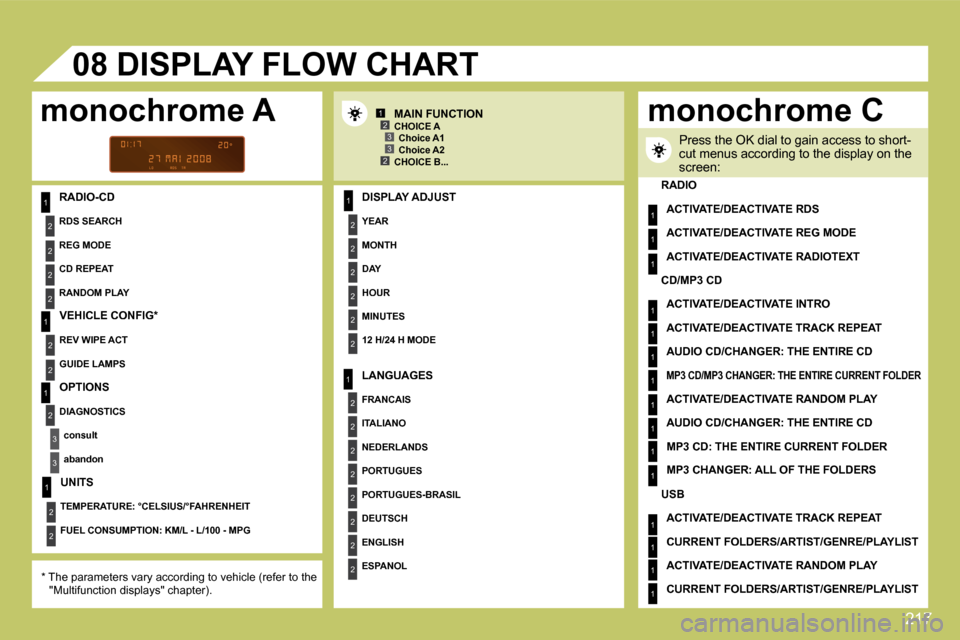
217
1
2
2
2
2
1
2
2
1
2
3
3
1
2
2
2
2
2
2
1
2
2
2
2
2
2
2
2
1
2
2
123
23
08
1
1
1
1
1
1
1
1
1
1
1
1
1
1
1
RADIO-CD
RDS SEARCH
REG MODE
CD REPEAT
DISPLAY ADJUST
YEAR
MONTH
DAY
HOUR
MINUTES
12 H/24 H MODE
DISPLAY FLOW CHART
MAIN FUNCTION
� � � �*� � � � �T�h�e� �p�a�r�a�m�e�t�e�r�s� �v�a�r�y� �a�c�c�o�r�d�i�n�g� �t�o� �v�e�h�i�c�l�e� �(�r�e�f�e�r� �t�o� �t�h�e� "Multifunction displays" chapter).
CHOICE A Choice A1 Choice A2 CHOICE B...
LANGUAGES
FRANCAIS
ITALIANO
NEDERLANDS
PORTUGUES
PORTUGUES-BRASIL
DEUTSCH
ENGLISH
ESPANOL
� �P�r�e�s�s� �t�h�e� �O�K� �d�i�a�l� �t�o� �g�a�i�n� �a�c�c�e�s�s� �t�o� �s�h�o�r�t�-�c�u�t� �m�e�n�u�s� �a�c�c�o�r�d�i�n�g� �t�o� �t�h�e� �d�i�s�p�l�a�y� �o�n� �t�h�e� screen:
monochrome A monochrome C
RADIO
ACTIVATE/DEACTIVATE RDS
ACTIVATE/DEACTIVATE REG MODE
ACTIVATE/DEACTIVATE RADIOTEXT
CD/MP3 CD
ACTIVATE/DEACTIVATE INTRO
ACTIVATE/DEACTIVATE TRACK REPEAT
AUDIO CD/CHANGER: THE ENTIRE CD
MP3 CD/MP3 CHANGER: THE ENTIRE CURRENT FOLDER
ACTIVATE/DEACTIVATE RANDOM PLAY
AUDIO CD/CHANGER: THE ENTIRE CD
MP3 CD: THE ENTIRE CURRENT FOLDER
MP3 CHANGER: ALL OF THE FOLDERS
USB
ACTIVATE/DEACTIVATE TRACK REPEAT
CURRENT FOLDERS/ARTIST/GENRE/PLAYLIST
ACTIVATE/DEACTIVATE RANDOM PLAY
CURRENT FOLDERS/ARTIST/GENRE/PLAYLIST
RANDOM PLAY
VEHICLE CONFIG *
REV WIPE ACT
GUIDE LAMPS
OPTIONS
DIAGNOSTICS
consult
abandon
UNITS
TEMPERATURE: °CELSIUS/°FAHRENHEIT
FUEL CONSUMPTION: KM/L - L/100 - MPG